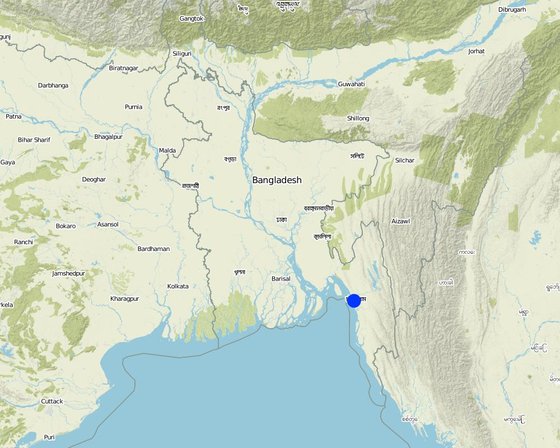Valley floor paddey cultivation through traditional system
(Bangladesh)
Description
The traditional approach of valley floor terraced rice cultivation at individual household level for their subsistance.
Aims / objectives: This approach basically concentrated on paddy cultivation for household consumption. All members of an individual family provide labours for execution of vartious activities with the aim to produce rice. The stages of implementation are site selection, land preparation (slash and clearing, weeding etc), construction of bunds and trenches, dressing of the hill sides, levelling of the lands and crop cultivation. Male and female play different role in the activities. Male farmers are involved in earth cutting, construction of bunds and trenches whereas the females help in seed sowing and harvesting. The farmers usually used traditional tools viz. dao, axe, spade etc.
Location

Location: Chittagong, Bangladesh
Geo-reference of selected sites
Initiation date: n.a.
Year of termination: n.a.
Type of Approach
-
traditional/ indigenous
-
recent local initiative/ innovative
-
project/ programme based
Approach aims and enabling environment
Main aims / objectives of the approach
The Approach focused mainly on other activities than SLM (Rice cultivation)
Paddy cultivation and income generation.
The SLM Approach addressed the following problems: Under utilization of land and water, unemployment and food scarcity are the main problems addressed by the approach.
Conditions enabling the implementation of the Technology/ ies applied under the Approach
Conditions hindering the implementation of the Technology/ ies applied under the Approach
-
Availability/ access to financial resources and services: lack of fund for the execution of different activities
Treatment through the SLM Approach: they engage family labour and also hired labours with the condition of late payment. They usually pay interms of goods (eg. Paddy) instead of cash.
-
Legal framework (land tenure, land and water use rights): Non recognition of customary rights
Treatment through the SLM Approach: Take recommendeations from concerned authorities (eg. Head man)
The existing land ownership, land use rights / water rights hindered a little the approach implementation
Participation and roles of stakeholders involved
Stakeholders involved in the Approach and their roles
| What stakeholders / implementing bodies were involved in the Approach? |
Specify stakeholders |
Describe roles of stakeholders |
| local land users/ local communities |
|
Lnad users basically implement at individual household level. Working land users were mainly men (Family members are engaged as day labourer at the different stages of the above mentioned activities.) Genetically females are physically weak. Male farmers are invilved in heavy works where as females are engaged with lite work at the different stages of activities. |
Involvement of local land users/ local communities in the different phases of the Approach
none
passive
external support
interactive
self-mobilization
Decision-making on the selection of SLM Technology
Decisions were taken by
-
land users alone (self-initiative)
-
mainly land users, supported by SLM specialists
-
all relevant actors, as part of a participatory approach
-
mainly SLM specialists, following consultation with land users
-
SLM specialists alone
-
politicians/ leaders
Decisions were made based on
-
evaluation of well-documented SLM knowledge (evidence-based decision-making)
-
research findings
-
personal experience and opinions (undocumented)
Technical support, capacity building, and knowledge management
The following activities or services have been part of the approach
-
Capacity building/ training
-
Advisory service
-
Institution strengthening (organizational development)
-
Monitoring and evaluation
-
Research
Advisory service
Advisory service was provided
-
on land users' fields
-
at permanent centres
Advisory service is very adequate to ensure the continuation of land conservation activities
Financing and external material support
Annual budget in USD for the SLM component
-
< 2,000
-
2,000-10,000
-
10,000-100,000
-
100,000-1,000,000
-
> 1,000,000
Precise annual budget: n.a.
The following services or incentives have been provided to land users
-
Financial/ material support provided to land users
-
Subsidies for specific inputs
-
Credit
-
Other incentives or instruments
Impact analysis and concluding statements
Impacts of the Approach
No
Yes, little
Yes, moderately
Yes, greatly
Did the Approach help land users to implement and maintain SLM Technologies?
The improvement includes reduction of run off and siltation.
Did other land users / projects adopt the Approach?
Among 13 families, 7 started first and the remaining six families joined with the approach later on.
Main motivation of land users to implement SLM
Sustainability of Approach activities
Can the land users sustain what hat been implemented through the Approach (without external support)?
Conclusions and lessons learnt
Strengths: land user's view
-
This approach is easy to execute.
-
It is nearby their residence.
-
This approach can enrich their family members.
-
Ensure staple food availability.
Strengths: compiler’s or other key resource person’s view
-
This approach is based on traditional/indigenous practices. (How to sustain/ enhance this strength: This facts should be emphasized while dessiminating /expanding the approach in order of getting more acceptibility.)
-
It is simple, easy to adopt. (How to sustain/ enhance this strength: The relevant publiuc literatures should be kept simple, jargon free and preferably in local language.)
Weaknesses/ disadvantages/ risks: land user's viewhow to overcome
-
Land slides sometimes brek down the drainage and thereby the whole system.
-
During monsoon due to heavy showers flash flood occurs leading to the damage of the crops.
Diversion of up-hill water flow into other ways.
Weaknesses/ disadvantages/ risks: compiler’s or other key resource person’s viewhow to overcome
References
Date of documentation: Des. 31, 2008
Last update: Aug. 3, 2017
Resource persons
-
Niaz Ahmed Khan (nakhan@spnetctg.com) - SLM specialist
-
A.F.M. Saleh (saleh2002bd@yahoo.com) - SLM specialist
-
Shekhar R. Biswas - SLM specialist
Full description in the WOCAT database
Documentation was faciliated by
Institution
- Dept. of Public Administration (Dept. of Public Administration) - Bangladesh
- IUCN-The World Conservation Union (IUCN-The World Conservation Union) - Bangladesh
- United Nations Development Program (United Nations Development Program) - Tajikistan
Project


